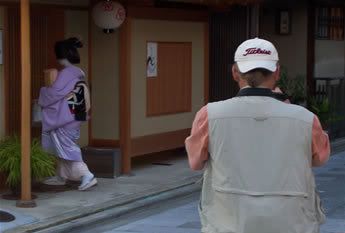Train lunch - Japanese style
The literal translation of the word 'Shinkansen' is 'new trunk line'. Not as exciting a meaning as it could be perhaps, but riding on the bullet train (a phrase which isn't used in Japan) is about as classical a Japanese experience as you can get. I'm not going to start the obvious comparisons with rail travel in the UK - but let's just say it woiuld take many, many leaves on the line to delay one of these things.
We arrived at Tokyo station early enough to buy an obento (boxed) lunch. After taking our allocated position on the platform (oh yes), the white torpedo-shaped train cruised slowly alongside. The journey to Kyoto took about three hours, but seemed faster - probably because of the scenery belting past the window at about the speed of sound. Every member of staff who passed through our carriage bowed to the passengers - from the guard to the young lad pushing the drinks trolley.
At first glance, Tokyo and Kyoto seem at completely opposing ends of the spectrum. The one exception is Kyoto station - it has several layers of platforms underground and then a nine-floor retail arcade on top. The pictures I took cannot possibly do it justice - imagine if the Death Star had a shopping mall - that might give you some idea of what it looks like. As I said though, that's the exception - the Kyoto we saw from our taxi (which in itself was immaculately presented) was very different to Tokyo. Admittedly we've only seen a fraction of each, but the first impression I got of Kyoto was the old age of the place. Of course, this is because Kyoto was deliberately avoided by the Allied bombers during WWII - you can only imagine what Tokyo would have looked like today.
Playing hunt the Geisha in Gion
To get a better idea of what Kyoto itself used to llok like, we joined a walking tour of the old Gion districts of the city. The guide was an ex-Canadian footballer (soccer player) who moved to Kyoto twelve years ago and married a geisha. Not surprisingly he knew an awful lot about the often-misunderstood profession, and was keen to quash some preconceptions. Geishas aren't prostitutes; they aren`t forced into their lifestyle; and apparently anybody can hire one. It`s not an easy process though - you need to become a member of a teahouse, which only happens if you are sponsored by a member and then attend dutifully for several years without incident.
Teahouses sign geishas like a sports team - and if you are well-liked you have a chance of hiring their star players. They sing, dance, play instruments, serve food and drink - essentially making you feel special. For this you can expect to pay several hundred dollars for the evening, assuming you are trusted enough to be left in their company. The walk was very interesting - I hadn`t a clue about the role of a geisha - but when we actually spotted one the mood instantly changed. They don't mind being photographed, apparently, and we saw a couple walking to their evening appointments - which prompted a barrage of photographs and the walk became something of a duck hunt.
The best part by far however, was when the guide (who was over 6ft and 20stone, by the look of him) hurriedly ushered us to one side of the street. Tottering in our direction was a wizened old man in sunglasses and a battered yellow t-shirt. He was walking a small dog, and a man my age dressed in black was qiuetly at his side. Our guide nervously whispered that this was a retired yakuza gang boss, and that we mustn't take pictures of him. Everyone obediently lowered their cameras as the old man approached. 'Good Evening he said, and turned the corner, his minder checking the road for cars.